|
Main Pages
Front Page
Overview
Seal FAQs
Design Process
1st Committee
Ben Franklin
Pierre Du Simitiere
First Selfie
2nd Committee
Francis Hopkinson
3rd Committee
Barton's Design
Final Design
Charles Thomson
Thomson's Design
Thomson Bible
Description
Explanation
Latin Mottoes
E Pluribus Unum
Annuit Coeptis
Novus Ordo Seclorum
Symbols (front)
Bald Eagle
Shield
Olive Branch
Arrows
Stars
Rays of Light
Cloud
Symbols (back)
Pyramid
Eye
MDCCLXXVI
Great Seals
Official Dies
First Engravings
First Painting
1792 Medal
Indian Medals
1882 Medal
One-Dollar Bill
Myths
Eagle Side
Pyramid Side
Themes
Unity
Peace
Liberty
Thirteen
Related
Wild Turkey
President's Seal
Sightings
Resources
|
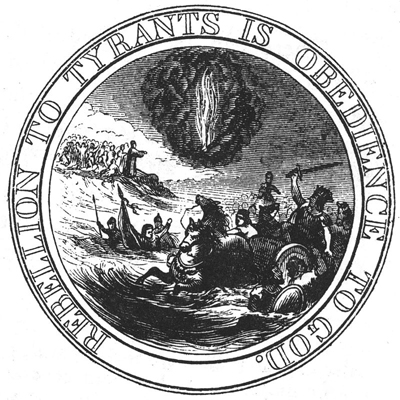
Benjamin Franklin's Great Seal Design
In the story of America's Great Seal, a particularly relevant chapter is the imagery suggested by Benjamin Franklin in August 1776. He chose the dramatic historical scene described in Exodus, where people confronted a tyrant in order to gain their freedom.
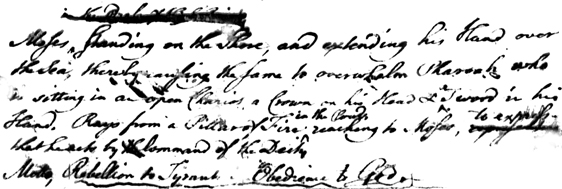
Benjamin Franklin's original handwritten description
of his Great Seal design (1776)
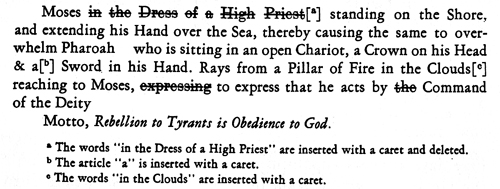
Transcription
Jefferson's edit of Franklin's design was recommended by the first committee for the reverse side of the Great Seal:
"Pharaoh sitting in an open Chariot, a Crown on his head and a Sword in his hand, passing through the divided Waters of the Red Sea in Pursuit of the Israelites: Rays from a Pillar of Fire in the Cloud, expressive of the divine Presence and Command, beaming on Moses who stands on the shore and extending his hand over the Sea causes it to overwhelm Pharaoh. Motto: Rebellion to Tyrants is Obedience to God."
Again, no sketch was made of their design. The above drawing was made by Benson J. Lossing for Harper's New Monthly Magazine in July 1856. (Lossing did not include a design element specified: "Rays from a Pillar of Fire in the Clouds reaching to Moses.")
Note: Jefferson's suggestion for the Great Seal was the children of Israel in the wilderness, led by a cloud by day and a pillar of fire by night.
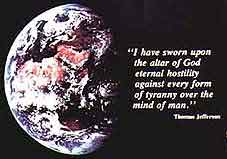 Jefferson liked the motto "Rebellion to Tyrants is Obedience to God" so much that he used it on his personal seal. Also, it seems to have inspired the upper motto Charles Thomson suggested for the final design of the reverse side of the Great Seal: Annuit Coeptis (God has favored our undertakings).
Jefferson liked the motto "Rebellion to Tyrants is Obedience to God" so much that he used it on his personal seal. Also, it seems to have inspired the upper motto Charles Thomson suggested for the final design of the reverse side of the Great Seal: Annuit Coeptis (God has favored our undertakings).
|
"Rebellion to Tyrants is Obedience to God"
echoes the Declaration of Independence:
"We hold these Truths to be self-evident, that all Men are created equal, that they are endowed by their Creator with certain inalienable rights, that among these are Life, Liberty, and the Pursuit of Happiness. . . whenever any Form of Government becomes destructive to these Ends, it is the Right of the People to alter or abolish it, and to institute new Government, laying its Foundation on such Principles, and organizing its Powers in such Form, as to them shall seem most likely to effect their Safety and Happiness."
The word government originates from an ancient word meaning "to steer or pilot," as with a ship. First and foremost, that ship's passengers and crew must be able to travel safely to their destination.
What is America's Goal?
According to the Declaration of Independence, it is to provide people with the opportunity to experience life and liberty, safety and happiness.
The Preamble to the U.S. Constitution elaborates:
We, the People of the United States are to:
- Form a more perfect union
- Establish justice
- Insure domestic tranquility
- Provide for the common defense
- Promote the general welfare
- Secure the blessings of Liberty to ourselves and our posterity
These goals require a government with the power to protect its citizens. The framers of the U.S. Constitution understood this and included a provision (Article IV, Section 4) that essentially says: The United States shall protect its people from foreign invasion and from domestic violence. And many considered self-inflicted harm the more likely threat to America.
Learn about this power to protect ourselves at
DomesticViolenceClause.org.
"All the armies of Europe, Asia and Africa combined could not by force take a drink from the Ohio or make a track on the Blue Ridge, in a trial of a thousand years. At what point then is the approach of danger to be expected? I answer, if it ever reaches us, it must spring up amongst us. If destruction be our lot, we must ourselves be its author and finisher." – Abraham Lincoln
|
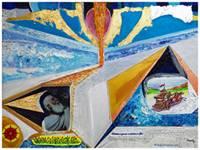 This full-color realization of Franklin's design was created by surrealistic artist Robin Heslop, whose acrylic painting is based solely on Franklin's written description. The result is strikingly original.
This full-color realization of Franklin's design was created by surrealistic artist Robin Heslop, whose acrylic painting is based solely on Franklin's written description. The result is strikingly original.
A Conversation with Ben Franklin
On the Eve of the New Millenium, December 1999

Master of the hoax
The "Titan Leeds" hoax in Franklin's first 4 Almanacks
Ahead of His Time
|

